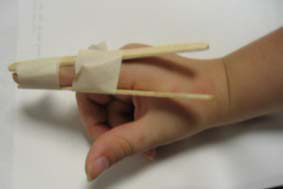1, 2, Robot Hands Please Tie My Shoe
(Lesson from the Oregon Museum of Science and Industry, on howtosmile.org.)
Robot Hands
In this activity, students will explore how sensing is part of robotics by tying their shoes with different constraints. After lacing their shoes normally, try it wearing thick gloves or with popsicle sticks taped to fingers so they can’t bend. Can students tie their shoes now? A connection is made to the limitations of the motion of robots, and to the role of design in allowing robots to perform different functions.
Standards:
National Science Standards:
Standard 2, Science as Inquiry

ITEA Technological Literacy Standards:
The Nature of Technology, Design:
Standard 8: Students will develop an understanding of the attributes of design
Standard 9: Students will develop an understanding of engineering design
Standard 10: Students will develop an understanding of the role of troubleshooting, research and development, invention and innovation, and experimentation in problem solving.
Preparation time: 5 minutes
Materials:
• Shoes that tie
• Popsicle sticks
• Masking tape
• Heavy gloves
• Cloth for a blindfold
• 2 pair of pliers
To do and notice:
 1. Try tying your shoes blindfolded. Was that hard? Even though you can’t see, you can still feel.
1. Try tying your shoes blindfolded. Was that hard? Even though you can’t see, you can still feel.
2. Take the blindfold off. Put on heavy gloves. Does this make it harder to tie the laces? Why?
3. Tape popsicle sticks onto your thumbs and forefingers. Is it easy to tie your shoes without bending your fingers?
4. Tie your shoes with pliers. The pliers remove your sense of touch and coordination.
Going further:
A robot with only a few joints isn’t very flexible. A robot without sensors can’t feel or see anything. How a robot is designed and built puts limits on the kind of job it can do.
For a deeper exploration of how robots and humans move, see “Are We Like Robots” at teachengineering.org.
photos: howtosmile.org, NASA
Filed under: Grades 6-8, Grades 9-12, Grades K-5, Lesson Plans
Tags: Class Activities, Lesson Plan, Museums, Robotics, Science









